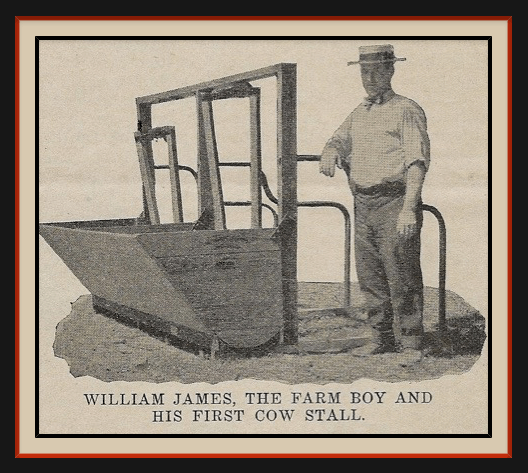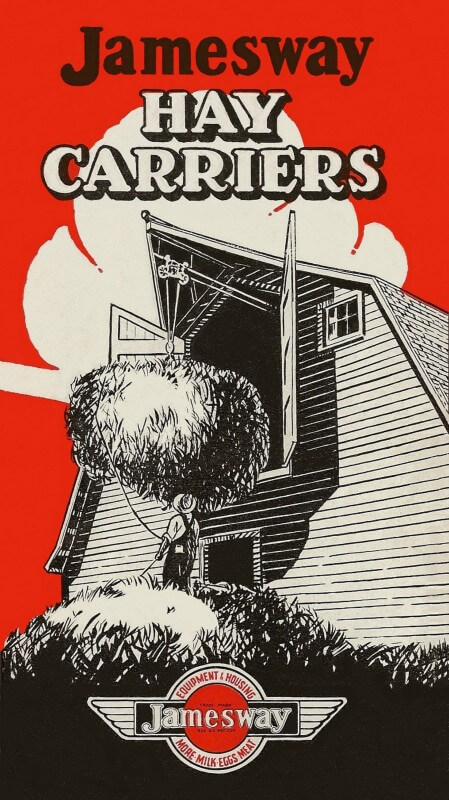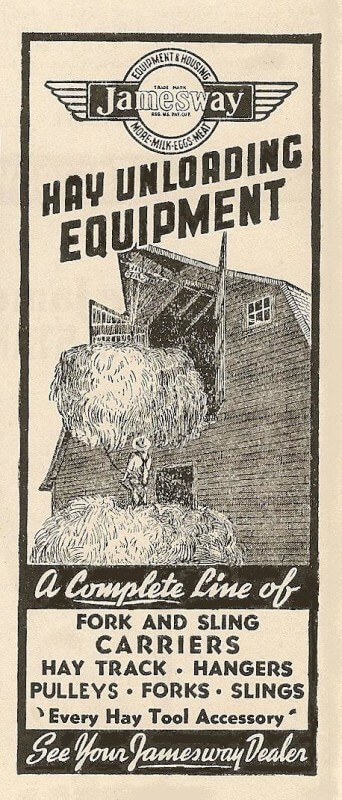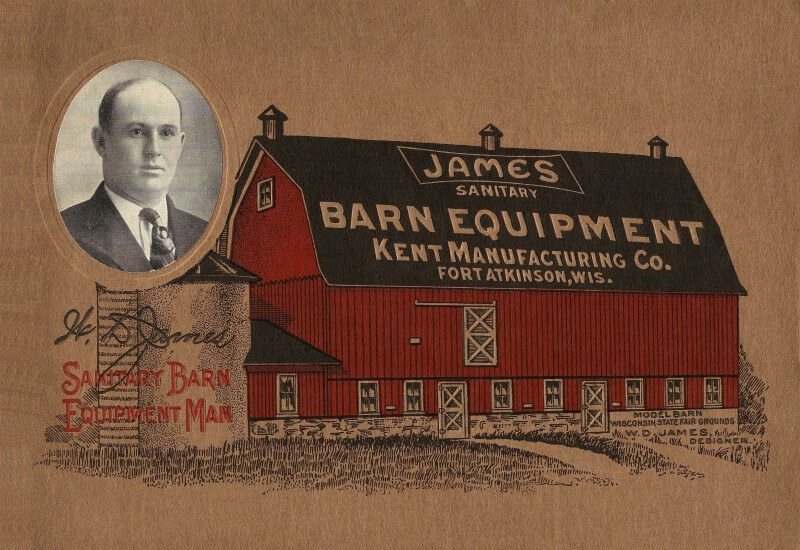
Headquarters:
Fort Atkinson, WisconsinAlso sold under the names (if applicable):
History:
William D. James (1881 – 1948)
 W.D. James fashioned the first cow stalls in a blacksmith shop on his father’s dairy farm in 1904. It is said that when he went to Fort Atkinson, Wisconsin, in 1906 to engage in the broader manufacture of dairy barn equipment he had only $2.50 in cash but a million dollars’ worth of honest purpose! There were some lean years when his manufacturing business was struggling for recognition. He continued to insist upon quality of materials and quality of workmanship. By 1919 The James Manufacturing Co., had grown into a great organization with branches in Minneapolis, Chicago, Fort Dodge Iowa, Elmira N.Y. and Philadelphia.
W.D. James fashioned the first cow stalls in a blacksmith shop on his father’s dairy farm in 1904. It is said that when he went to Fort Atkinson, Wisconsin, in 1906 to engage in the broader manufacture of dairy barn equipment he had only $2.50 in cash but a million dollars’ worth of honest purpose! There were some lean years when his manufacturing business was struggling for recognition. He continued to insist upon quality of materials and quality of workmanship. By 1919 The James Manufacturing Co., had grown into a great organization with branches in Minneapolis, Chicago, Fort Dodge Iowa, Elmira N.Y. and Philadelphia.
IN HIS OWN WORDS:
My father, D.D. James, was born and raised near Wales, Wisconsin. He settled on a small farm and was a hard worker. I suppose he instilled the love of work in me. I’m happiest when I’m at work. We had a few cows, raised the feed for them, milked them in an old cow barn and shipped the milk to Milwaukee. It was not as good milk as it should have been. The barn and equipment were about the same as many of our neighbors. It had rough siding, an old plank floor, rigid, unyielding, unsanitary wood stocks, not enough light and no ventilation. While milking one night, in 1904, I began to think of the little children in the city who would drink the stuff the next morning that was foaming up in the pail. I began to think of myself as a producer of human food. The thought came to me whether I’d care to eat my mother’s bread if she’d knead it in the barn! I figured it wasn’t square to the consumers to try to produce a clean product under our conditions nor was it fair to our cows, myself or my dad.
I figured the cows must be very uncomfortable in the stiff and wholly unyielding wood stocks. They could not turn their heads to drive away the flies from their necks and shoulders. I began to reason that it would not only be more humane if I could fix it so the cows would be more comfortable, but that comfortable cows could and would give more milk. Dad and I did some talking and the upshot of our planning and scheming was a revolving stanchion. We got some hickory from the woods and with some strips of iron, pounded out in the farm blacksmith shop, we fashioned the first James Cow Comfort Stanchion. We put a little Jersey into it – but she had too much freedom – the first night she swung around and trampled on the udder of the cow lying next to her. It didn’t take me long to put in a 2×4 partition between her and her neighbor. Pretty soon I bent a partition out of iron pipe. Now I had a stanchion that provided real “pasture comfort” for the cow, while tying her securely, and a stall partition that afforded protection both to her and her neighbor.
Next, Dad and I turned our attention to sanitation. We put in more windows and laid a concrete floor with a gutter back of the cow. Now all the manure went into the gutter and we had a clean stall for milking and the cow had a clean bed to lie on. We were much gratified that we could produce a cleaner product, cut down our work in tending the cows and that the added comfort made it possible for the cows to give more milk. Our barn and “newfangled” ideas became the talk of the neighborhood. Folks would drive in on Sundays just to see it. One fellow asked us to make up 20 stanchions for him. About this time, Charles Perry Goodrich, a lecturer at Farmers’ Institutes, well known for the work he was doing to further the dairy interest of the country; talked to us at length about giving other dairymen the benefit of our experience.
So it was, in 1906, I came to Fort Atkinson, with about $2.50 in my pocket, but believing in myself and my ideas and in the American dairy farmer. A few men who had some money and believed in me that the proposition of building comfort, cleanliness, and protection for the good old cow had real merit, backed me up – and we started in business.
 It was a slow, uphill effort for the Jamesway enterprise. Mr. James often wondered where the $35 monthly payroll dollars would come from. He traveled Wisconsin by rail, when the budget allowed, personally boasting the merits of his product. He took an exhibit to the State Fair; talked all day and slept in the tent at night. Lots of folks listened; but many just laughed at him and called him crazy. Mr. James said the turning point came when he was showing his stalls at the Second National Dairy Show at the Stockyards in Chicago. A man from Lexington, Kentucky, gave him an order for 200 stalls; provided he would go down to his farm and look the entire proposition over and tell him what he could do to make his dairy right! Gradually from that point, farmers everywhere began writing to ask about the James stalls and other equipment and for help in laying out a good floor plan for their barn.
It was a slow, uphill effort for the Jamesway enterprise. Mr. James often wondered where the $35 monthly payroll dollars would come from. He traveled Wisconsin by rail, when the budget allowed, personally boasting the merits of his product. He took an exhibit to the State Fair; talked all day and slept in the tent at night. Lots of folks listened; but many just laughed at him and called him crazy. Mr. James said the turning point came when he was showing his stalls at the Second National Dairy Show at the Stockyards in Chicago. A man from Lexington, Kentucky, gave him an order for 200 stalls; provided he would go down to his farm and look the entire proposition over and tell him what he could do to make his dairy right! Gradually from that point, farmers everywhere began writing to ask about the James stalls and other equipment and for help in laying out a good floor plan for their barn.
Up to this time, barns were just “barns.” No one had paid much attention to making the barn an efficient factory for the production of milk. While still on the farm Mr. James first realized how much work and time could be saved in doing the daily chores, how much cleaner, healthier, and more comfortable the cows would be, how much more pride the dairyman would take in his work, if the barn were properly arranged, properly lighted, ventilated, and modernly equipped. So it was that when he began manufacturing equipment he was anxious that his customers should get all the value they could from their investment. He was not only furnishing so many feet of steel pipe and so many pounds of iron; but cow comfort, cleanliness, and protection, and easier, pleasanter work for the dairyman.
From the very first, W.D. James tried to help the dairyman get a good interior layout. He studied barn planning and arrangement and developed new methods of handling the work in the dairy barn. When, in 1909, the Wisconsin State Board of Agriculture appropriated $9,000 to build a Model Dairy Barn on the State Fair Grounds; Mr. James was well equipped to enter the competition and his plan was selected. Jamesway Company growth continued with plant expansions every couple of years to meet demands. In 1916 the Eastern business had grown to such proportion that a branch plant at Elmira, New York was established. A branch at Minneapolis was also opened. In 1925 Jamesway boasted they were the largest manufacturers of dairy barn, horse barn, hog barn, and poultry house equipment and ventilation in the world having serviced nearly 100,000 of the best farmers in the country!
During the early years, Jamesway had but a few trained men serving the more densely “cow-populated” sections of the country. Elsewhere they only served the farmer by means of so-called plan books and “stock” plans through the mail. It was recognized that every individual contemplating a new farm building or remodeling had specific challenges which needed to be addressed in a more personal manner. W.D. James set out to build an organization of Jamesway Men that could provide a personal, firsthand contact with the farmer. A direct representative of the company and responsible to it. The Jamesway Man would become a positive influence to the farmer resulting in better livestock buildings, more profitable farming operations and easier ways to get the chores done. By 1925 there were 150 Jamesway Men on the job from Maine to Minnesota – working with county agents, milk testers and veterinarians; to be of genuine service to the farmer planning future growth and profits.
A 1924 circular boasted that besides the head office and main manufacturing plant covering several acres; a large wood and metal working plant was also located at Ft. Atkinson, Wisconsin; totaling 367,000 sq. feet. Factories at Mt. Joy, Pennsylvania and 240,000 sq. ft. of manufacturing in Elmira, N.Y. served the East coast. Later another plant was located in Los Angeles, California, devoted mainly to the manufacture of equipment for West Coast farmers.
Over the years Jamesway greatly expanded and improved its facilities for the process known as Hot-Dip Galvanizing. At the peak of metallurgic science, a heavy coat of zinc spelter – sometimes as much as seven ounces per square foot, was applied. Thirty pounds of galvanize was used to cover the same amount of surface once covered by one pound of aluminum paint. Where a high quality, long-life painted enamel finish was appropriate, Jamesway also met the challenge with technology. A seven stage “Bonderizing” process began by shot-blasting the metal then applying the Bonderite agent which uniformly etched the surface and acted as an insulating agent between the metal and enamel. The paint was “floated” onto the surface with low pressure nozzles as opposed to spraying – no mixing of air into the paint. Finally, the product passed through the high temperature baking ovens; ensuring added years of life for the equipment.
W.D. James contributed significantly to the development of modern farm buildings. The twenty year period, 1906-1926, brought about greater progress in farm building design than in all preceding centuries! The thousands of Jamesway designed farm buildings attest to his knowledge and practical experience. Mr. James maintained there never was a piece of Jamesway equipment in the luxury or semi-luxury class. His equipment was built to pay its own way and add to farm profits. It had to serve through years of hard use and be a genuine convenience. This was the foundation upon which he built the largest business of its kind, with satisfied customers in all parts of the world.
 By 1956, when the James Manufacturing Co. was purchased by The Marmon Group of companies, it was a North American leader in cattle and dairy equipment, but only one of many manufacturers of poultry and swine equipment. New management streamlined the company by selling off the intensely competitive poultry and swine product line, with the exception of the incubator production. In 1959, a Jamesway product engineer developed a revolutionary incubation system marketed as the “Big J.” Hatchery personnel could now collect hatching eggs on the farm in the same egg flats that would be used in the incubator, eliminating hours of laborious traying. Jamesway was the first incubator manufacturer to receive a patent for a plastic egg flat and the first incubation system to use rolling egg trolleys, so that egg work could be done outside the incubator, substantially reducing wetting and transfer time, and egg breakage as well. In 1983 Jamesway purchased the incubator division of the Butler Manufacturing Co., and consolidated manufacturing at Cambridge, Ontario.
By 1956, when the James Manufacturing Co. was purchased by The Marmon Group of companies, it was a North American leader in cattle and dairy equipment, but only one of many manufacturers of poultry and swine equipment. New management streamlined the company by selling off the intensely competitive poultry and swine product line, with the exception of the incubator production. In 1959, a Jamesway product engineer developed a revolutionary incubation system marketed as the “Big J.” Hatchery personnel could now collect hatching eggs on the farm in the same egg flats that would be used in the incubator, eliminating hours of laborious traying. Jamesway was the first incubator manufacturer to receive a patent for a plastic egg flat and the first incubation system to use rolling egg trolleys, so that egg work could be done outside the incubator, substantially reducing wetting and transfer time, and egg breakage as well. In 1983 Jamesway purchased the incubator division of the Butler Manufacturing Co., and consolidated manufacturing at Cambridge, Ontario.
Jamesway® is today recognized as one of the major incubator manufacturers in the worldwide hatchery industry. Though the company has dramatically changed since its beginnings in the early 1900’s our commitment to this industry remains unchanged.
In May of 2001 Jamesway was purchased by FPS from the Netherlands. FPS also owns two other well-known poultry related companies, Petersime of Belgium and Moba of the Netherlands. Today Jamesway is dedicated to the design, manufacture, marketing and servicing of hatchery systems. Continuous reinvestment has resulted in the company operating some of the most advanced computer controlled manufacturing equipment in the industry, including robotic welders, presses and a programmable metal fabrication machine.
Source: Article written by Dennis Mcgrew